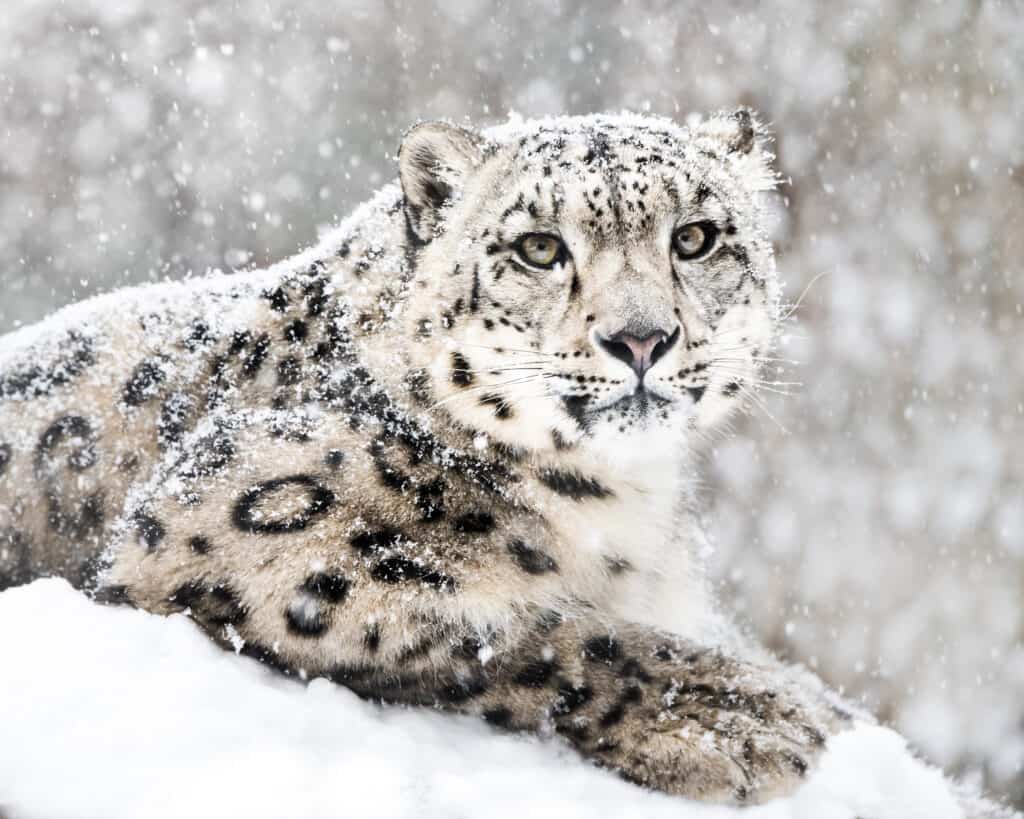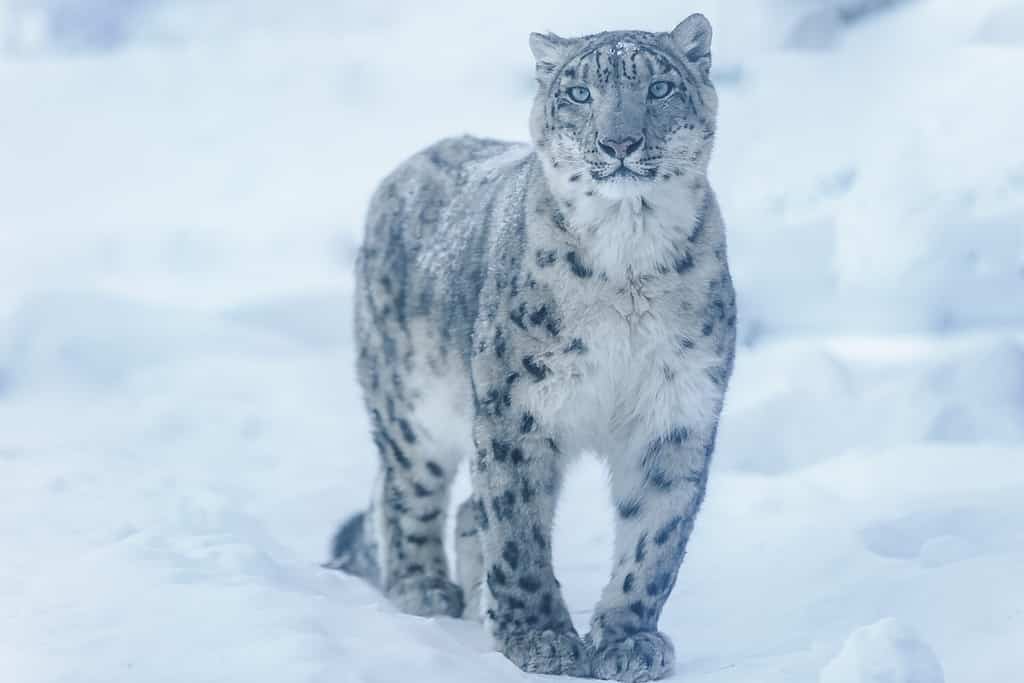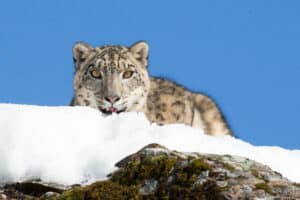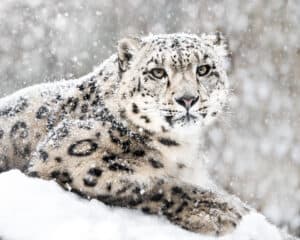Snow leopards (Panthera uncia) are a species of large wild cat native to the mountainous regions of Central and South Asia, spanning 12 countries, including Afghanistan, Bhutan, China, India, Kazakhstan, Kyrgyzstan, Mongolia, Nepal, Pakistan, Russia, Tajikistan, and Uzbekistan. Here these elusive and majestic cats thrive in the most remote and mountainous areas.
Explore the habitats of these elusive cats and why they thrive in their rugged homes. Also, delve into their fight for survival and conservation efforts to preserve the species.
Snow Leopards: Distinct Characteristics

The elusive snow
leopard
is rarely seen by people.
©Abeselom Zerit/Shutterstock.com
Snow leopards are known for their unique characteristics and are distinct from other wild cats in several ways:
These elusive cats have several distinguishing physical features, including:
- A dense, thick fur coat that is pale gray or smoky gray with rosettes and spots to provide camouflage in snowy and rocky terrain.
- A long, bushy tail that helps with balance and warmth in cold climates.
- Relatively short and stocky body proportions adapt to conserve heat in cold environments.
- Large nasal cavities that help them breathe in thin, high-altitude air.
The distinctive rosette markings on their fur help them blend into their rocky surroundings. These rosettes are large, irregularly shaped spots with a dark center and a lighter border.
Snow leopards are smaller in size compared to other big cats like lions and tigers. They typically weigh between 60 to 120 pounds (27 to 54 kilograms), with males being larger than females.
Rarely seen in groups, snow leopards are solitary and elusive creatures. They are highly territorial, and their territories can cover vast areas in the mountains. These behaviors minimize encounters with other predators.
Their primary prey includes mountain ungulates, such as blue sheep (bharal), ibex, and argali sheep. They are expert climbers and can ambush their prey from above.
The Rugged Terrain Snow Leopards Call Home

Mount Everest is in the
Himalayan
mountains, home to the snow leopard.
©Vixit/Shutterstock.com
Snow leopards adapt to live in harsh, high-altitude mountain environments. They are typically found at elevations between 3,000 and 5,500 meters (9,800 to 18,000 feet) in rugged terrain.
1. Himalayan Range
Snow leopards call the towering peaks of the Himalayas home, specifically India, Nepal, and Bhutan. These snow-clad heights offer solitude and an abundance of prey. Many areas, like Hemis National Park in India, provide regulatory protection for the cats.
2. Karakoram Range
In the Karakorams of Pakistan, snow leopards roam freely. These rugged terrains provide the perfect camouflage for their spotted coats. The Gilgit-Baltistan region is well known for its snow leopard conservation efforts, with Khunjerab National Park being a significant habitat.
3. Pamir Mountains
The Pamir Mountains of Tajikistan and Afghanistan, also known as the ‘Roof of the World,’ are a sanctuary for snow leopards, thanks to their extreme isolation. Tajikistan has established preserves like the Zorkul Nature Reserve to protect the snow leopards.
4. Altai Mountains
In the Altai Mountains, where Russia, Mongolia, China, and Kazakhstan converge, snow leopards adapt to the frigid conditions. The Uvs Nuur Basin Biosphere Reserve in Mongolia is a critical area for their protection.
5. Tian Shan Mountains
The Tian Shan Mountains in Kyrgyzstan and Kazakhstan house a resilient snow leopard population, thriving in this harsh yet picturesque environment. Kyrgyzstan’s Sarychat-Ertash State Nature Reserve in the Tian Shan Mountains plays a pivotal role in safeguarding these big cats.
Snow Leopards: Masters of Adaptation

One of the snow leopard’s unique adaptations is its ability to blend into their environment.
©Aleksandr Denisyuk/Shutterstock.com
Snow leopards, known as ‘ghosts of the mountains,’ are unparalleled predators. They’ve honed their survival skills in some of the planet’s most challenging environments. These exceptional survival skills include:
- Camouflage Kings: Snow leopards’ grayish-white fur with black rosettes allows them to blend seamlessly with their surroundings.
- Incredible Agility: They’re acrobats of the wild, gracefully navigating steep cliffs and rocky terrain.
- Masters of Stealth: Snow leopards are masters at sneaking up on their prey, thanks to their silent movements.
- Large Territory: A single snow leopard may need a territory spanning 100 square miles to find enough prey.
- High-Elevation Experts: Snow leopards are uniquely adapted to high altitudes, where oxygen is scarce.
Why Snow Leopards Thrive in These Regions
Abundant Prey
In these regions, blue sheep and ibex flourish, providing a substantial food source for snow leopards.
Remote Wilderness
The rugged landscapes act as natural barriers, limiting human intrusion and preserving the snow leopards’ habitat.
Extreme Adaptation
Snow leopards’ thick fur and long tail help them endure extreme cold, and their powerful legs enable them to leap across gaps as wide as 50 feet.
Minimal Competition
Few natural predators exist in these high-altitude habitats, allowing snow leopards to rule as apex predators.
Cautious Reproduction
Snow leopards reproduce at a slow rate, with females giving birth to only two to three cubs every two years, ensuring their numbers remain sustainable.
Threats to The Snow Leopard’s Survival
Snow leopards face several hazardous threats in the regions where they reside. These threats include:
Habitat Loss and Fragmentation
Rapid urbanization, infrastructure development, and agricultural expansion are encroaching upon snow leopard habitats. As human populations grow, these big cats lose their territory, leading to habitat fragmentation and reduced prey availability.
Poaching and Illegal Wildlife Trade
Snow leopards are hunted for their fur, bones, and other body parts, which are highly valued in traditional medicine and the illegal wildlife trade. Poaching remains a significant threat, as these activities can decimate local populations.
Retaliation Killings
Snow leopards occasionally prey on livestock, leading to retaliatory killings by local herders protecting their livelihoods. This human-wildlife conflict can result in the loss of snow leopards and intensify negative perceptions of them.
Climate Change
Climate change affects the snow leopard’s habitat by altering vegetation patterns, prey distribution, and water sources. Melting glaciers and changing weather patterns can disrupt their ecosystems, making it challenging for them to find food and water.
Conflict and Political Instability
Regions inhabited by snow leopards often experience political instability, which can disrupt conservation initiatives and enforcement efforts.
Addressing these threats requires a multi-pronged approach that includes habitat protection, anti-poaching measures, community engagement, research, and international cooperation. Conservation organizations, governments, local communities, and the global community must work together to safeguard the future of these magnificent creatures.
Conservation Efforts

Snow leopards face numerous threats, including habitat loss, poaching, and human-wildlife conflict.
©Chris Desborough/Shutterstock.com
Snow leopards are listed as “Vulnerable” on the International Union for Conservation of Nature (IUCN) Red List of Threatened Species. They face numerous threats, including habitat loss, poaching, and human-wildlife conflict.
Efforts to conserve snow leopards are ongoing, recognizing the importance of preserving these apex predators and their habitats. Conservation initiatives include:
- Protected Areas: Establishing protected areas and national parks to limit human encroachment and protect prey species.
- Community Involvement: Engaging local communities in conservation efforts to reduce human-wildlife conflicts and poaching.
- Research and Monitoring: Studying snow leopard behavior and populations to inform conservation strategies.
- Anti-Poaching Measures: Implementing anti-poaching patrols and initiatives to combat the illegal wildlife trade.
- International Collaboration: Working across borders to create a unified approach to snow leopard conservation.
Snow leopards are awe-inspiring creatures that thrive in the remote, high-elevation regions of Central and South Asia. They have evolved to conquer the harshest conditions, making them true mountain masters.
However, these elusive cats face numerous challenges, including habitat loss, poaching, and climate change. Conservation efforts are critical to ensure that future generations can marvel at the beauty and resilience of these ‘ghosts of the mountains.’
The photo featured at the top of this post is © Asmakhan992/Shutterstock.com
Thank you for reading! Have some feedback for us? Contact the AZ Animals editorial team.






